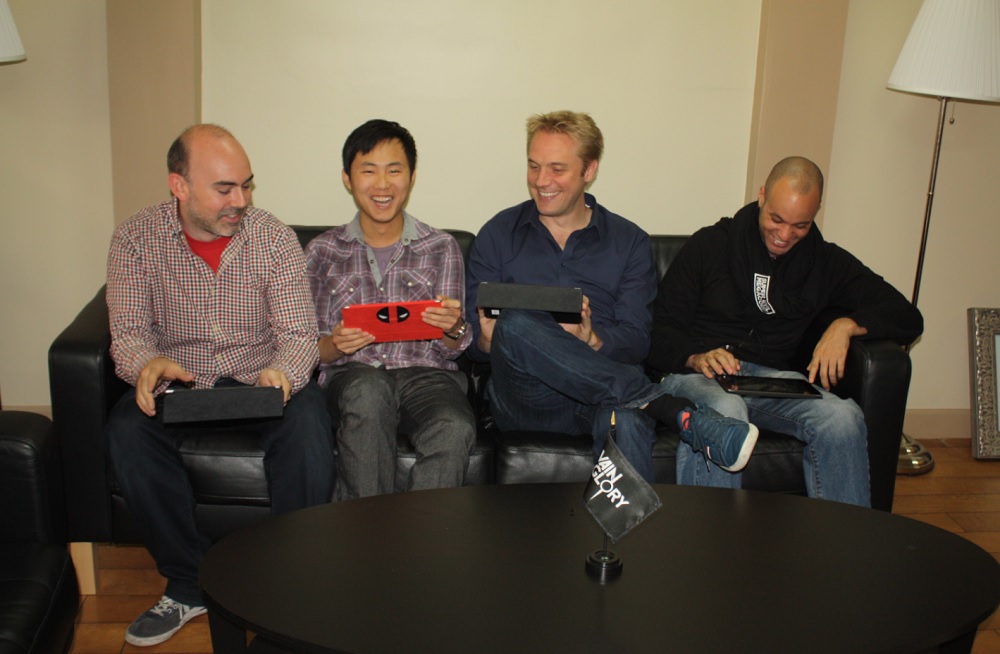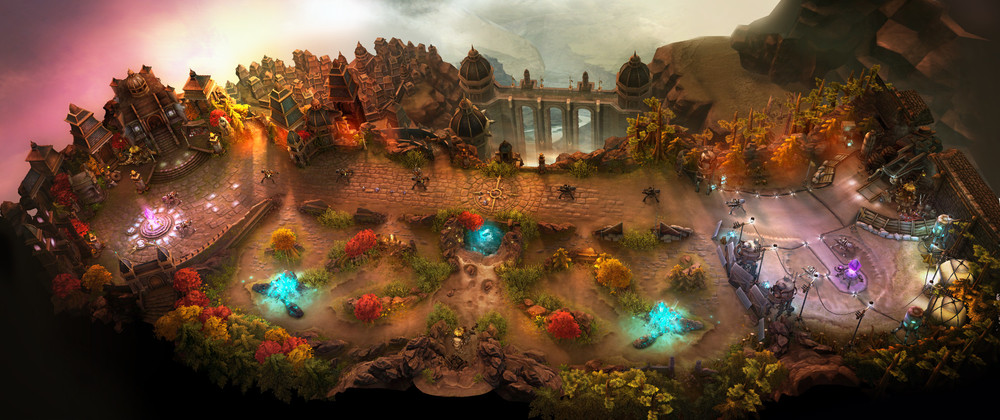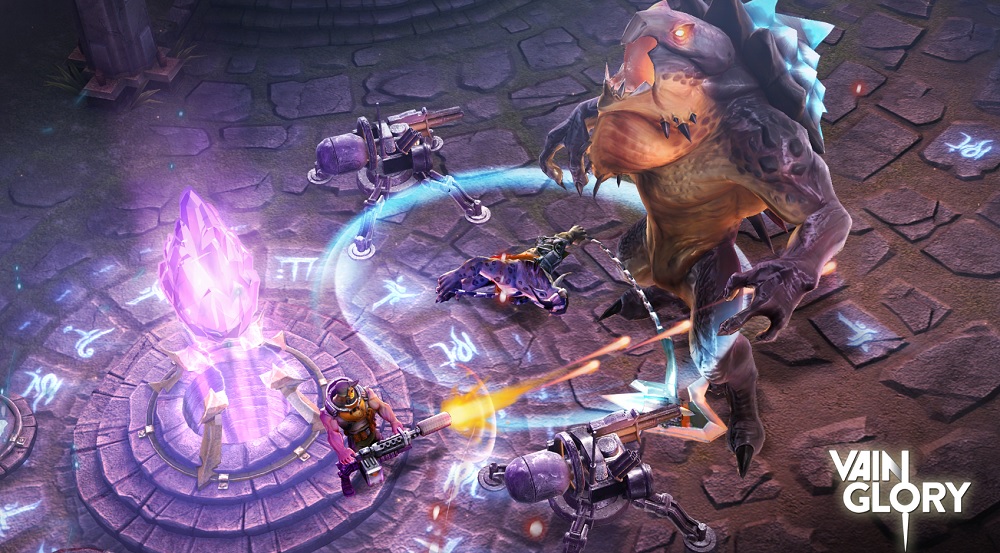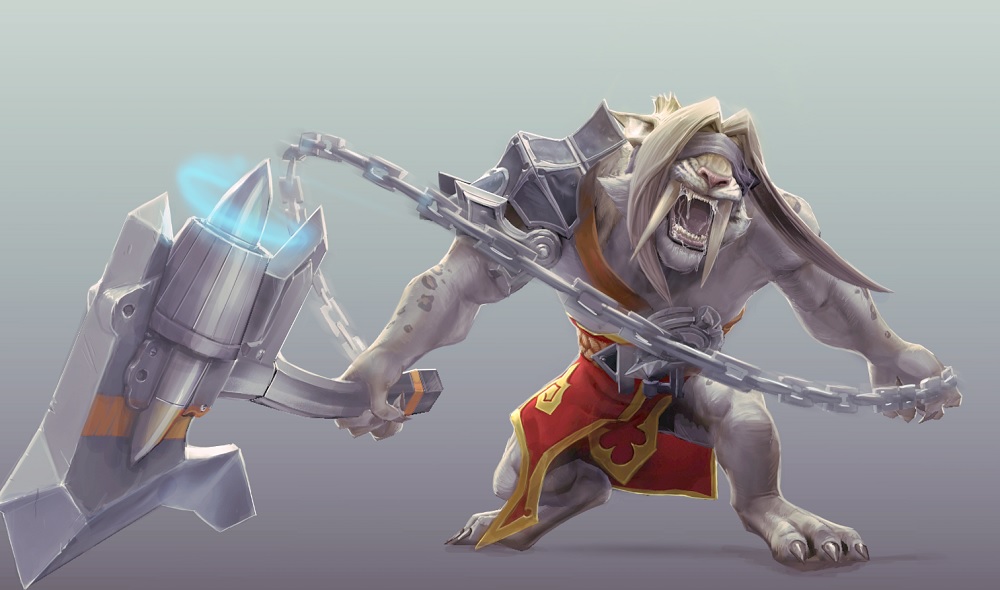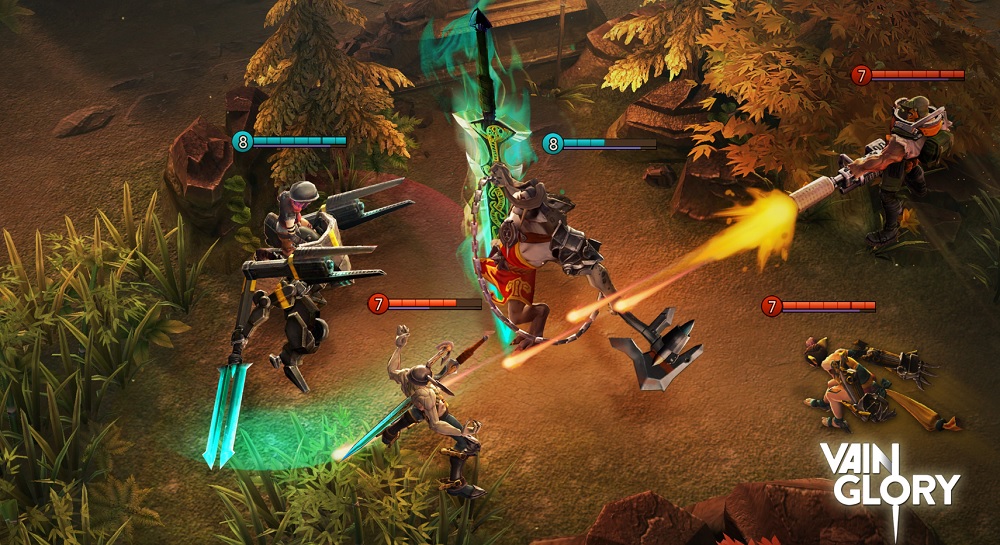Game studio Super Evil Megacorp scored some big publicity when its first game, Vainglory, a multiplayer online battle arena tablet and smartphone game, made an onstage demo at Apple’s recent press conference for the iPhone 6’s introduction. The company showed off how its console-quality 3D graphics could work over Wi-Fi in real-time matches against other players with iPads without skipping a beat because of bad connectivity.
The team — led by chief executive Bo Daly, chief operating officer Kristian Segerstrale, and cofounder Stephan Sherman — designed this MOBA in the same vein as Riot Games’ League of Legends, but it’s for tablet players first. The team created the Evil Engine, the foundation for the graphics and gameplay, to work on tablets. It launches today on the Apple iTunes App Store after almost two years of development.
It’s a big effort for the San Mateo, Calif.-based Super Evil Megacorp, which recently raised $15 million for the effort and brought Segerstrale — cofounder of Playfish and former head of digital at Electronic Arts.
A lot of eyeballs will be watching this sector, as the game could open a new category of hardcore games on mobile device if it succeeds. I played a few rounds with the team and interviewed Sherman and Segerstrale afterward. Here’s an edited transcript of our interview.
GamesBeat: I’ve seen the demos onstage. Could you start at the beginning, how you had the idea to do this?
Stephan Sherman: When we were younger, a bunch of the founders and myself, we used to play a lot of really intense competitive games. When we were in college, I was in my dorm room with my three buddies. We would be up all night playing things like Street Fighter, Marvel vs. Capcom 2. When I was in grad school I played a whole bunch of Counter-Strike. We played StarCraft in the computer labs in Sitterson Hall [at the University of North Carolina at Chapel Hill].
There were so many vibrant, intense experiences that helped codify social relationships with people. We ended up creating lifelong memories and lifelong friendships. We’ve always had a sort of hallmark or throwback to those memories. Now, we’ve brought that same kind of passion and love that we have for competitive and richly social games to what we aspire to create here.
Vainglory was a conversation that emerged from looking at what we could do to create the same kind of experiences and memories that we had always had for the next generation of gamers coming up behind us. This is the touch generation, the gamers that are growing up on mobile and other touch platforms. Looking at this space, there weren’t that many opportunities for those kinds of experiences. We wanted to re-create those truly authentic, hardcore gaming experiences we enjoyed on PC and consoles and bring them to the touch generation.
It’s about the experience. First and foremost, that’s what we want to crack. It’s more important to me that people feel something, that they have these kinds of enriched experiences, than for it to have a specific kind of mechanic or a specific set of features or back-of-the-box issues. We wanted to crack what the player feels. That’s where we started from and it’s been our guiding light throughout the process of creating Vainglory.
GamesBeat: If you took something like League of Legends and put it straight down on a tablet, it wouldn’t run that well. The controls would be difficult. You can’t just do that.
Sherman: No, that doesn’t work. When we were first having these conversations, we were first deciding, can it be done? And if it can be done, what needs to happen for it to come across successfully and faithfully?
We started by breaking down what it is that contributes to what you feel when you play these kinds of games. Whether you’re playing on console or PC, all these things matter — your input, your body posture, the way you interact with the device. We wanted to make sure that we ended up honing in and solving those problems uniquely for the touch platform.
For us, it was starting off with input. How do we make the input very organic? How do we keep your hands out of the way of your eyes? How do we end up making it so that it feels very natural and intuitive? How do we keep very quick responsiveness? All the hallmarks of hardcore game input, which is necessary to solve before any real genre can claim to meet the expectations of a hardcore community. Fast, quick input is key.
After that it was talking about how we ensure that what you’re playing is not the platform. It’s not anything about you being in a room. That all has to fade into the background. You’re just playing your opponent. There has to be this point where you just unleash. It’s only about you versus them, not about how you’re sitting or what you’re touching. That has to be able to fade away.
Just bringing over a product from a different platform and shoehorning it into a new one is — my hunch is that can’t be successfully done. We didn’t even try. We tried to re-imagine, re-create that experience with what the platform gave. It was reinventing from the ground up.
GamesBeat: I expect this took a lot of iteration.
Sherman: We started iterating on the game the moment the game was even slightly playable. By iteration I mean we have required company playtests. We all have to play the game every day. You can’t really tell whether you’re crafting that kind of emotional experience if you’re not sampling the experience every day.
Very early on, when the game wasn’t fun or we didn’t think things were connecting up, we would have conversations. Where are we missing our connection points? What do we need to change and evolve to capture the experience? At that point it wasn’t about capturing a set of mechanics. It was about capturing the way you feel when you have those kinds of experiences on different platforms.
GamesBeat: So you have maybe 365 prototypes by now?
Sherman: We have many more than that. We’d do multiple prototypes within a single day. It began with us understanding deeply about the anatomy of hardcore games in general, as well as this game specifically. What pieces can we keep? What pieces have a little elasticity that we can use to change them? Figuring out how to rebirth those experiences on the platform and then sampling it over and over again. It’s very difficult. I will never sell the idea that doing something like this is easy. It takes craftsmanship and attention and patience before something emerges with that flavor you’re looking for.
Kristian Segerstrale: Following these guys from the outside as an investor – a friend of mine from Playfish was a co-founder, so I knew him well – one of the things that was most impressive from the start was that commitment to figuring everything out from first principles. Not lifting some PC game or taking the monetization mechanics from some other tablet game, but thinking about the games that will played in the future on this platform. How will they create those moments of awesomeness that all of us have been part of as we grew up as core gamers?
That willingness to really think it through and test and test, as opposed to just assuming — in some ways it’s been fun watching the touch gaming ecosystem grow from, initially, just lifting Facebook games and putting them on the touch screens and then evolving from there. What we’ve seen so far in attempts to make core games on touch screens, there are two flavors. One is taking mechanics that are as shallow as some of the old Facebook mechanics and putting fancy graphics around them. That’s been pretty deeply unsatisfactory. The other flavor has been taking a console or PC game and trying to cram it into a tablet without necessarily doing much to make it feel native to device. That hasn’t been particularly successful either.
All of us have a deep conviction, though, that in the next couple of years someone’s going to figure out how to make a truly native experience that ultimately helps define the platform as a core gaming platform. That’s what we’re all looking forward to. Hopefully we’ll be a part of that, but if not us, someone will do it.
GamesBeat: Did you have e-sports in mind as you worked on this?
Segerstrale: I think I speak for all of us when I say we’d love to, but it’s something you have to earn your way to. You can’t just say you’re making an e-sport. We’re hoping to make a game that feels competitive and deep enough that ultimately players will feel it’s a worthy arena.
Sherman: Your community decides whether it’s an e-sport, far more than you do. The best you can hope for is to develop a product with a deep mindset of craftsmanship that any product that could become an e-sport requires. We’ve had some of that emerge among early players. They’ve sent photos from places like Singapore where they go LAN-party together.
GamesBeat: How much time passes between when you get it into a geo-lock and when you can get done? Is it necessarily a six-month process?
Segerstrale: It was ready to open up in early January, just in Singapore. Since then it’s been working with that community. But it’s awesome to run into players in the wild and play against them now, the people who’ve been with us since the beginning. It’s gratifying when you bump into them randomly in solo queue, either with them or against them. “I know you. You’re going to kill me.”
Sherman: They are very, very good.
Segerstrale: But they’ve become a trusted group. They’ve become strong guardians of the community. There’s been so much effort from our end to build a positive community from the start, but we owe a lot to our early player base for reinforcing that and welcoming in new players. MOBAs can become a toxic place online. We’ve been fortunate at our scale so far to be able to generate a positive community.
GamesBeat: Do you roll content into that geography as if it were almost live?
Segerstrale: We’ve had a live service running since January. We do weekly news feed updates, messaging, forums. The fun thing is, we had players in the low tens of thousands participating through the last eight or nine months. But before we opened up Australia and New Zealand a few weeks ago, those guys had already posted more than 20,000 posts on the forums. That community was already very tight.
In general, the game is beginning to feel like it’s more or less ready for prime time. There are lots of features that aren’t in yet that we’d love to have in. We’ll have a pretty interesting feature update in the next six or 12 months. But at its core, we owe a lot to the player base in southeast Asia with helping us crystallize around the things that are the most important in the game.
GamesBeat: How would you say it’s different or unique compared to other games in the genre that are out there or being worked on? Fates Forever is another example that’s out there.
Segerstrale: I think there are three things about Vainglory that make it somewhat different from other efforts in core gaming. One is the engine itself. The Evil engine, which has been worked on for multiple years, is optimized to give extremely high performance, both in control responsiveness and graphical execution, specifically for these kinds of games. We hope that translates into gameplay that feels like it’s been crafted for core game players, that delivers on the expectation of alacrity, if you like. Very precise gameplay where you’re not fighting the device. There are no gimmicks in the controls. It’s all very precise. In some ways I’d say we’re trying to create gameplay that feels worthy of the core gamer.
Second is that, as I alluded to earlier, it’s designed from the ground up. As Stephan was talking about earlier, it’s iterated from very first principles, as opposed to saying, “Okay, let’s take some modes and heroes and kits from an existing MOBA and put them into this platform and see what happens.” Everything about the game has been crafted from scratch. The map layout, the design of the control and hold points, is totally unique for this game. It creates gameplay moments that end up feeling very different from what you have in any other MOBA on any platform.
The third thing, which is more of a meta-point I suppose — and ultimately the reason why I both invested in and ended up joining this company — any product, over time, is the result of talent plus culture in your company. One of the amazing things about this place is how everyone is a core gamer. Everyone plays the game every day, both internally and together with our community. We team queue with our players in Singapore and elsewhere. When people take a break here, they grab a coffee and they come here and play. The level of commitment to that core game excellence in the company is something we hope will shine through over time in the amount of attention to detail in every part of the experience.
Sherman: I can’t speak for other products so much, but for us, our initial guiding principles have situated Vainglory in such a place that I can say the emotional experience is there. It’s in there.
Part of that is the job of listening to how the room sounds when people are playtesting. When we talk about feedback, our feedback is awkward because it’s often emotional. The number one question I ask people when they’re done with a playtest is, “How do you feel?” A lot of things may be right. There will be a lot of things that might not be as right. But amongst all of that, what was the general feeling, the overall experience the game left you with? It’s important for us to know when that is frustration, when that is boredom, when that is ambivalence. All of those things are key indicators. Charting and understanding why people feel the way they feel is important.
We also do a careful job about crafting anticipation into our game, which is an important part of making the experience explode into these moments of cheering or shouting or high-fiving across a table. Having those moments you can share afterward — “It was so amazing when this happened!” — you want to have a microcosm in which those experiences emerge. If you don’t, it doesn’t have the same tone and feeling as you get when you play a MOBA on a different platform. Making sure those things happened was important to us. It helped shape the way Vainglory ended up.
GamesBeat: How did you catch Apple’s attention?
Segerstrale: One of the really big advantages that we’ve had is controlling our full engine and net stack. The company has been consistently touting a vision of core gaming on touch screens for a long time. When Apple unveiled their Metal technology this summer, it was something that was really attractive for us to work on, because we have a multiplatform engine that was designed for that. It found its home, in some ways. As part of that effort, one thing led to another.
GamesBeat: You didn’t have to do much to make it Metal-compliant, Apple’s new way to code to take advantage of a device’s graphics firepower?
Sherman: No. One of the features of the Evil engine was that it was written, from day one, to be hyper-portable, meaning we can put the engine on a variety of platforms. Anything we could think of and a bunch of things we couldn’t think of at the time when we were writing it.
When you start, from your first line of code, with that precept, it makes the porting work you have to do whenever a new platform emerges very quick and easy. It’s much tougher if your engine was not written from the idea that it was going to take advantage of different platforms, and platforms that vary dramatically in the amount of power that they might be able to put in the hands of the consumer. If you haven’t started with that precept, it’s very challenging to port your engine.
We do our ports in a very short amount of time. When a new platform comes up, we just say, “Okay, let’s give it a try.” That helped us a lot when we were working with Apple.
Segerstrale: The hardest part was actually, because the engine is so efficient, the gameplay and all its elements have been designed around the assumption that it should run at 60 frames per second on an iPad 2. If that’s your basic requirement, then once you have access to the near-limitless power in these new devices, plus Metal, how do you use that power in a way that’s not just visually pleasing, but makes sense in the game environment? It was fun to watch that come together.
I wish we’d kept a visual diary of how it evolved. The amount of butterflies, dust particles, wind, cloud shadows, all that stuff that took an environment that was already very pretty and added this whole layer of stuff on it, without interrupting gameplay. The tech was done quickly. Then it was people scratching their heads asking, “Now what do we do with the tech?”
Sherman: Apple likes to work very closely with the developer community in any of its efforts. We were just really lucky to have gotten their attention.
GamesBeat: On an iPad Air 2, versus the regular iPad 2, would you notice a big difference?
Segerstrale: One of the things we’re proud of is that when it comes to playability and gameplay, there is no difference, no advantage. It’s equally smooth. Everything runs the same way. But boy, is it more beautiful.
VentureBeat's mission is to be a digital town square for technical decision-makers to gain knowledge about transformative enterprise technology and transact. Learn More

